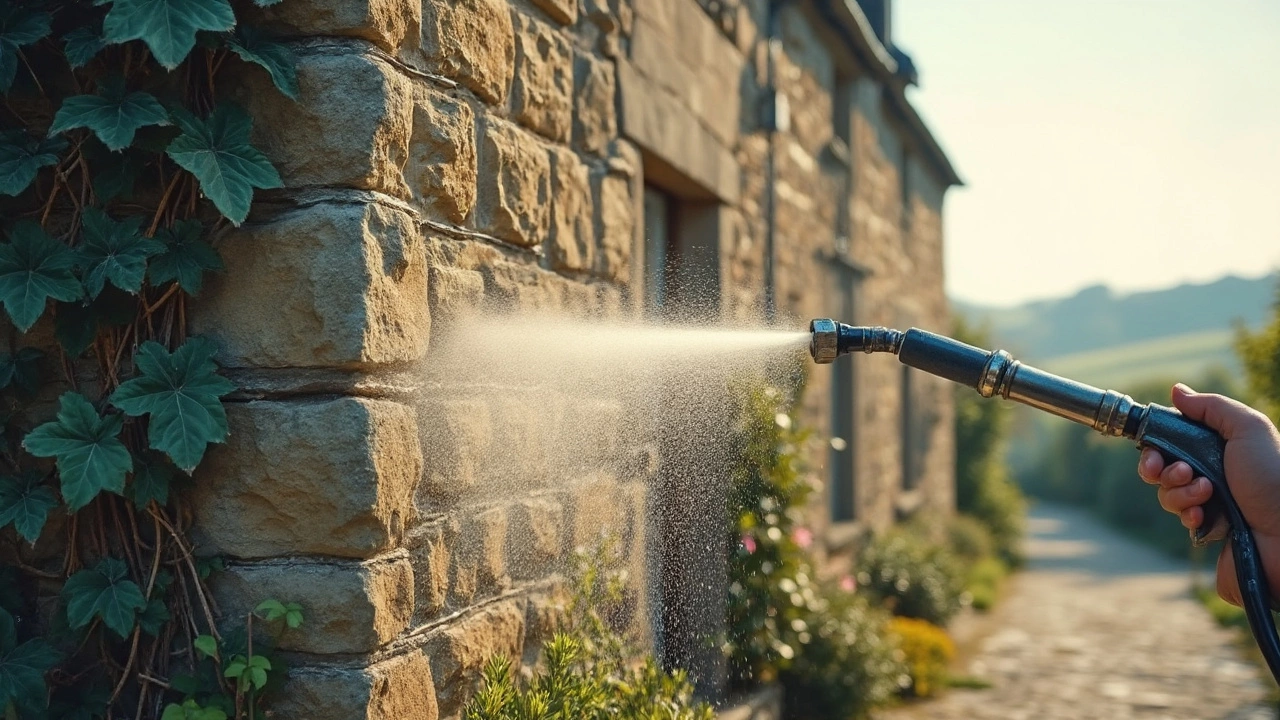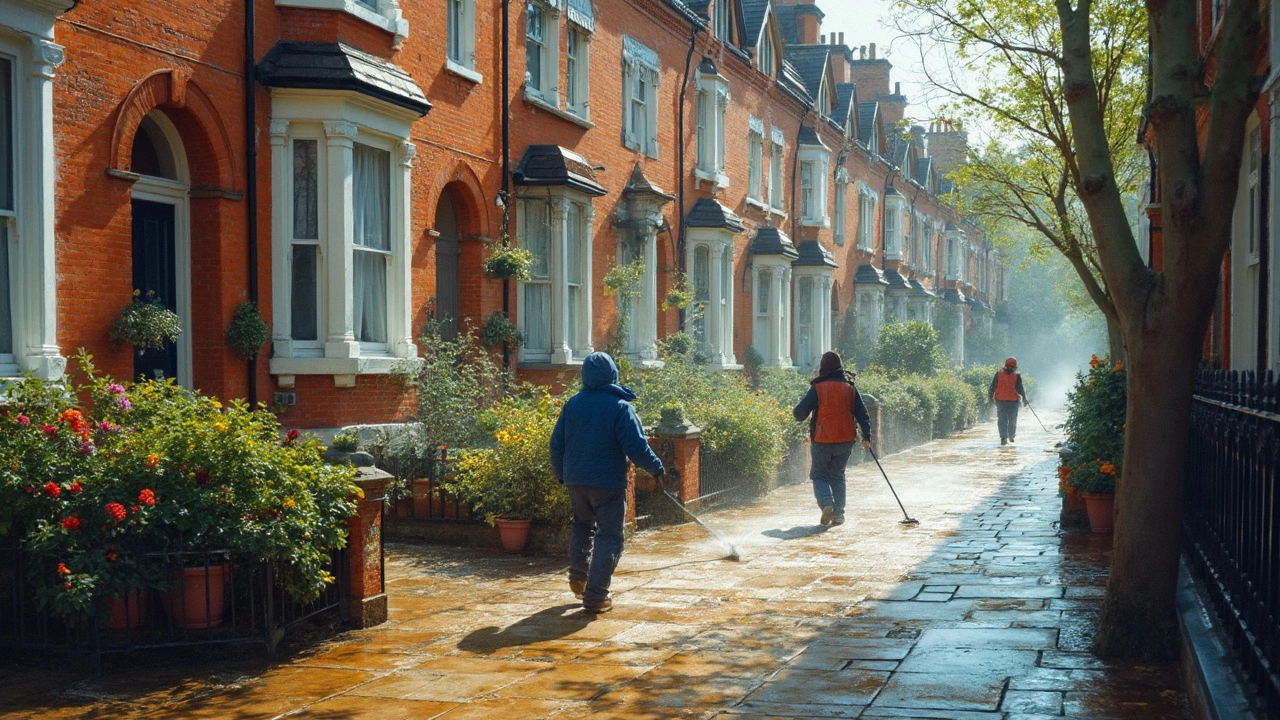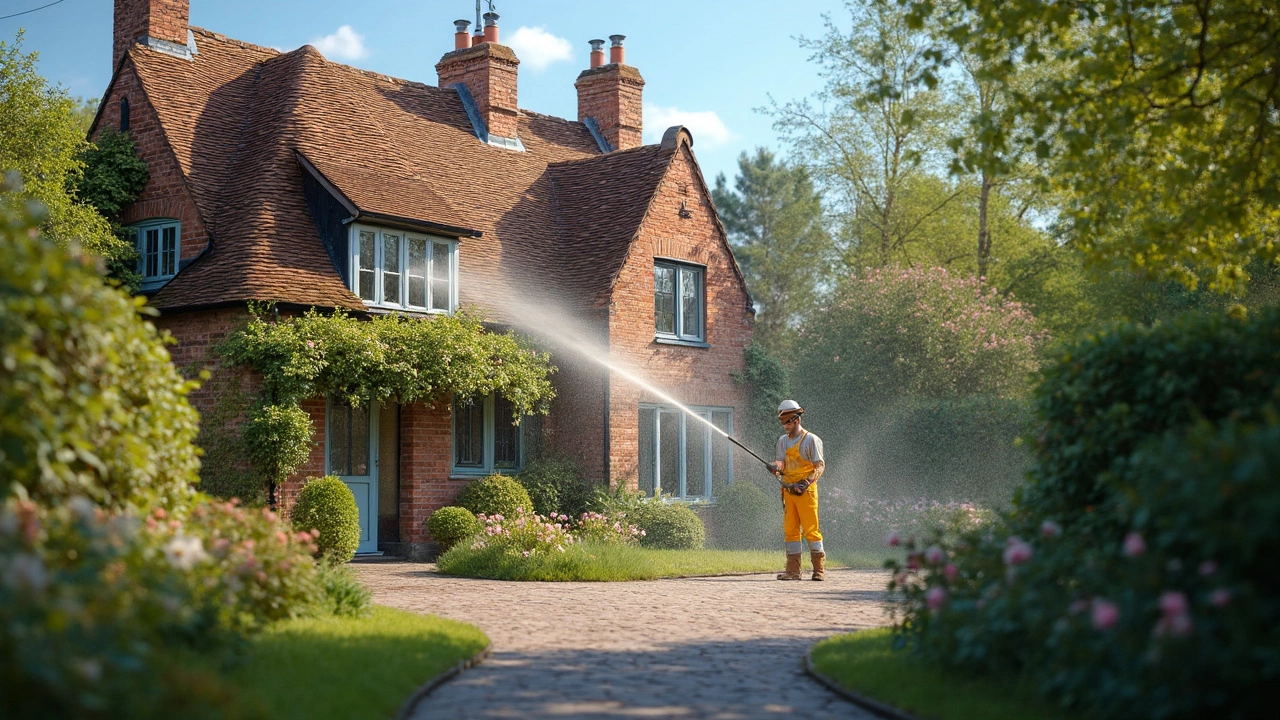Picking the right PSI (pounds per square inch) for washing your house can be a game changer. It's more than just blasting away the dirt—get it right, and you've got yourself a sparkling home; get it wrong, and well, you might end up with more than just clean windows, if you know what I mean.
So, what's the deal with PSI anyway? Well, it’s the measure of how much force a pressure washer can put out. Too low, and you'll be left scrubbing away those stubborn stains. Too high, and you might damage the siding or other delicate surfaces.
Let’s break it down: for softer surfaces like wood siding, you’re looking at a sweet spot of about 500 to 1200 PSI. Stucco or aluminum might need a bit more oomph, up to 1500 PSI. Now, if you’re thinking about cleaning that grimy driveway, you can bump it up between 3000 and 4000 PSI. That ought to do the trick.
Remember, it’s not just about the PSI—distance from the surface and the nozzle in use also play a massive role. Different surfaces demand different approaches, so always check what PSI is recommended for yours. Stay smart and keep your home looking its best without a hassle!
- Understanding PSI and Its Importance
- Choosing the Right PSI for Different Surfaces
- Factors Affecting Your PSI Choice
- Tips for Safe and Effective Pressure Washing
- Common Mistakes to Avoid
Understanding PSI and Its Importance
Alright, let’s get down to it. PSI, or pounds per square inch, is one of those technical terms that often gets tossed around in the pressure washer world. But why does it actually matter when you're sprucing up your house?
Think of PSI as the pushing power of your garden hose on steroids. It tells you just how hard the water is hitting the surface you're cleaning. This is crucial because, depending on the material you're working on, too much pressure might end up doing more harm than good. Imagine stripping paint or etching unwanted lines into your lovely siding—that'll take the sparkle out real quick, won't it?
The Sweet Spot
Now, most home exterior cleaning tasks are covered by a PSI range between 1,000 to 3,000. That's the Goldilocks zone for many surfaces. But it's not just about the numbers. Higher PSI levels are great for removing mildew, dirt, and grime, but they should be matched with the right nozzle and technique for the best results without damage. Think of wood siding or paint—too much pressure and you’re in trouble!
Why Lower PSI Isn’t Always The Answer
You might think, "Hey, I'll just play it safe and go low PSI all the time!" Not so fast. Too little pressure can lead to ineffective cleaning, leaving you frustrated and your surfaces less than clean. It means you might have to re-do the job you thought was finished. Waste of time, right?
A Balancing Act
So, when you're choosing the best PSI, consider these factors:
- Surface type: Like we said, delicate surfaces need less to avoid damage.
- Task intensity: Stubborn grime might need a nudge with a higher PSI.
- Cleaning area size: Larger areas might benefit from more pressure to save time.
Remember, pairing the right PSI with the correct nozzle and maintaining a safe distance will go a long way. This not only helps in achieving a cleaner surface but also extends the life of the wash.
Understanding PSI is key to making your pressure washer not just a tool, but a cleaning ally. So next time you gear up to tackle your house, remember: the right PSI is your best friend for that perfect glow!
Choosing the Right PSI for Different Surfaces
When tackling the pressure washing of your home, understanding the right PSI for house washing is key. Let's break it down surface by surface, so you don't end up regretting your choices!
Wood Surfaces
If your home has wood siding or decks, you're going to want to be gentle. A PSI range of 500 to 1200 should do the job without causing any splintering or damage. Always remember, it's better to start on the lower end and slowly increase if needed. Use a fan tip nozzle to spread out the water and reduce pressure.
Vinyl Siding
Vinyl siding can handle a bit more pressure. Aim for around 1300 to 1600 PSI, but again, be cautious of any brittleness or aging in the material. Too much pressure could crack or tear it apart. For moldy sections, a bit of cleaning agent can help instead of bumping up the PSI.
Concrete and Brick
For tough surfaces like concrete driveways or brick walls, you can unleash the big guns. Here, a pressure washer set between 2500 to 3000 PSI is more appropriate. These surfaces can withstand a lot more force, but don't go overboard and risk etching or leaving marks.
Delicate Materials
Now, if you have any delicate trims or painted surfaces, you're going to want to dial it way back—keeping it under 1000 PSI. The aim is to clean, not strip away the paint or finish.
Everything considered, the key is adjusting your pressure washer to match the surface's needs and vulnerability. Just be sure you're standing the right distance from the surface, usually about a foot or two, depending on its condition.
| Surface Type | Recommended PSI |
|---|---|
| Wood Siding & Decks | 500 - 1200 PSI |
| Vinyl Siding | 1300 - 1600 PSI |
| Concrete & Brick | 2500 - 3000 PSI |
| Delicate Materials | < 1000 PSI |
The right PSI for home cleaning changes with the landscape. Remember, it's not one-size-fits-all, so take your time in assessing the surface before you get started. Happy cleaning!

Factors Affecting Your PSI Choice
When picking the PSI for house washing, it’s not just about matching numbers to surfaces. There are several factors you need to consider to get the job done right.
Material and Surface Condition
The material you’re working with really matters. A brand-new brick wall isn't the same as a decades-old wooden fence. Newer materials might take a bit more pressure, but older, weathered ones need gentler handling to avoid damage.
Distance and Angle
How far you hold the nozzle can make a world of difference. The closer you are, the more intense the spray. Start with a greater distance and slowly move closer to find that sweet spot without causing harm. And keep that angle in mind! Aiming the stream directly might be too harsh; whereas, angling it can provide a gentler cleaning effect.
Nozzle Type
Nozzles are not just for show. They control the spread and intensity of the water. A 0-degree nozzle gives you a precise, intense stream—great for really tough spots on driveways but a menace to your house paint. Opt for 25-degree or 40-degree nozzles for larger, gentler coverage suitable for siding and other fragile parts.
Water Temperature
Though most people stick with cold water, warm water can boost cleaning power, especially for oily stains. But beware! Hot water combined with high PSI might damage surfaces not designed for such treatment.
Environmental Conditions
Weather can throw a curveball in your pressure washing plans. Wind can mess with the water direction, and direct sunlight might dry surfaces too rapidly, leaving streaks behind. Shooting for early mornings or overcast days usually gives you the best conditions.
By keeping these factors in mind, you’ll not only ensure effective cleaning but also prolong the life of your surfaces. This balanced approach is key to keeping everything looking fresh without unnecessary wear and tear.
Tips for Safe and Effective Pressure Washing
Getting the most out of your pressure washer while keeping your home safe is all about knowing how to handle the beast. Here are some top-notch tips to make sure you’re washing like a pro.
Start with the Right Gear
First things first, gear up right. Goggles to protect your eyes and gloves for your hands. You don’t want any surprises, like debris flying where it shouldn’t. Safety is always cool.
Choose the Correct Nozzle
The nozzle can change everything. Most pressure washers come with a few nozzle tips, ranging from 0 to 40 degrees. For house washing, stick to a 25 or 40-degree nozzle—a higher angle gives a softer spray, perfect for siding and windows.
Mind the Distance
Too close, and you risk damaging your surfaces. A good rule of thumb is to keep the nozzle at least 6 to 12 inches away from the surface. Adjust as needed based on grime level and surface fragility.
Follow a Systematic Approach
- Test First: Always start on a small, hidden area to ensure you’re good to go without any damage.
- Top to Bottom: Pressure wash from the top down. This prevents dirty water streaks on freshly cleaned areas.
- Keep it Moving: Never stop at one spot for too long. Keep the nozzle moving to avoid gouging or damaging the surface.
Aim for Optimal PSI
For most homes, sticking between 1500 and 3000 PSI should do the job effectively without overdoing it.
Watch the Weather
If you can, pick a day that's not too hot and definitely not freezing. Mid 60s in Fahrenheit, or around 18°C, is ideal. Warm enough to dry, but not enough to dry too quickly.
Stats to Consider
Here are some quick figures to help gauge your task better:
| Surface | Recommended PSI |
|---|---|
| Wood Siding | 500-1200 PSI |
| Brick | 1500-2000 PSI |
| Concrete | 2500-3000 PSI |
And there you have it! Master these, and your house will thank you with a cleaner, fresher look—like it just got a new suit. No fuss, no damage, just a sparkling home.

Common Mistakes to Avoid
Let's talk common slip-ups with pressure washing that are super easy to make but also super essential to dodge. These no-nos won’t just save your house from potential damage, but they’ll also make your cleaning sessions way more effective.
Using Too High PSI
Alright, first mistake—the temptation to crank up your machine to the max. It might seem logical that higher pressure equals cleaner house, but that’s a fast track to damaging your siding or even blasting holes in wooden surfaces. Stick with the recommended PSI for house washing for the best results without the risk.
Ignoring Surface Variations
Different surfaces mean different needs. Your concrete driveway can handle a lot more pressure than your vinyl siding. Same goes for soft surfaces like painted areas—gentle is the key. A universal PSI for home cleaning doesn't exist; it's all about specific surfaces.
Wrong Nozzle Choice
Yes, nozzles matter! They modify the spray angle and intensity. A zero-degree nozzle can carve lines on your wood deck, while a 40-degree one lightly rinses your windows. Keep a keen eye on what you’re using on which surface.
Skipping a Test Spot
It’s easy to get overconfident, but it’s wise to test the pressure on a small area first. Avoid surprise damage by checking if the pressure setting and nozzle choice work well on a hidden spot.
Neglecting Safety Gear
Bare feet and pressure washers don't mix. Think common sense: your home is getting spruced up, but your eyes, ears, and skin need protection too.
| Common Mistake | Consequence |
|---|---|
| Too high PSI | Surface damage |
| Ignoring surface type | Ineffective cleaning |
| Wrong nozzle | Inconsistent results |
| No test spot | Unexpected damage |
| No safety gear | Personal injury |
Knowing these pitfalls helps ensure that your everyday pressure washing session remains effective and free from unnecessary setbacks. Stay cautious and keep your cleanup process smooth and safe!
